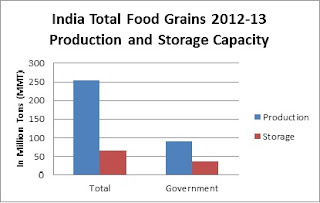But the real question remains, will the bill reach the populations it aims to provide for?
 |
| Photo 1: A truck transporting grains near Lucknow, UP |
According to press statements by the Food Minister, K.V. Thomas, the bill would allow large quantities of wheat, rice and coarse grains such as millet to be distributed from the overflowing storage sites. However, the methods for such distribution have not been addressed. The scheme highlighted in the bill is proposed to be implemented through the Public Distribution System (PDS), a system which has been severely criticized for its 51% leakages and is riddled with corruption. Shop-owners steal or over-charge, the beneficiaries receive poor quality food grains, and the system is heavily burdened with red tape. Critics argue extending the PDS to monitor this mega food program would provide another avenue for leakages.
and when the stock arrives, the customers entitled receive a cell phone message alert. A randomized study conducted by the National University of Singapore stated that such reforms allowed for 98% of the entitled population to receive the allocated grains.







